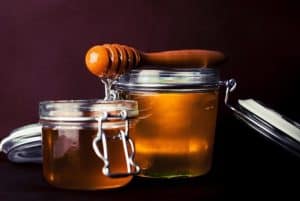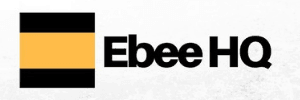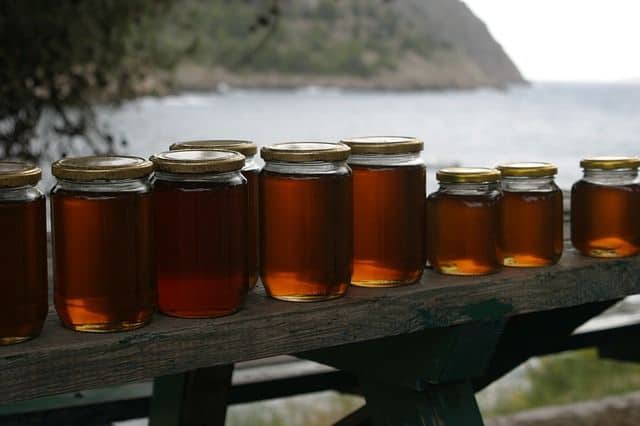Last Updated: 19 December 2025
Honey is the tasty reward you get for being a beekeeper. Just like many creative processes, the honey produced by your bees can sometimes feel like your very own artwork! Well, not really, but you get the idea…
When the time comes to harvest honey, some beekeepers may become apprehensive as the process can seem daunting. In this article, I’ll show you how to harvest honey from a hive without killing the honey bees or causing any harm to the hive.
Table of Contents
🍯When is The Hive Harvest-Ready?
The extraction of honey is the high point of beekeeping. It’s not difficult to know when it’s time for the harvest. When you looking in one of your hives supers and notice that there are wax caps covering the honeycombs, then it’s time.
Before you begin the harvest, you must determine if the hive is ready to be harvested. To know when the time is right, ask yourself the below questions:
🐝When is the “honey flow”?
Knowing when there is one or more major nectar sources in bloom is what beekeepers call “honey flow” or “nectar flow”. When the flow is high, you can add supers (honey frames) to help increase honey storage, making conditions ideal for the harvest.
🍯When is the right window for my harvest?
Now that you know about the “flow”, picking a window for the harvest should be easy. It’s not the same time for everyone because it will depend on where you live and whether or not your bees have enough honey stored for the winter. You don’t want to attempt a harvest too early and neither do you want to do this late.
🐝How do I identify a finished capping?
For beginners, knowing what type of honey to expect from the hive will be impossible. The process of turning nectar into honey involves the bees digestive enzymes, as well as their storage and fanning efforts.
The honey produced, can vary from hive to hive, but when it is ready, the comb’s cells will be capped over with wax. This only happens when the bees have reduced the moisture in the nectar down to about 18%. Comb capping typically means that the honey is ready for harvest.
Get to know your hive and anticipate their needs. Never take more honey than absolutely required. The general rule of thumb is to leave 40-60 pounds of honey so that the bees can get through winter and not go hungry.
Remember, the honey inside the brood chamber is only for your bees sustenance during the winter. If you are harvesting in late summer, then you don’t have to worry about this because there is ample time to produce more honey.

How to Collect Honey From a Beehive | 8 Steps
Extracting honey requires the following steps to be followed:
- You’ll need a protective beekeeping suit
- Use Bee Escape or Smoker to Calm the Bees
- Remove the frames from the hive
- Set up your workstation
- Remove wax cappings
- Extract the honey
- Bottle up your Honey!
- Return the frames to the hive
So you’ve picked a window for the harvest. All you have to do is remove the honeycombs in a way that is safe for you and safe for your bees as well. The first thing you need to do is gather all the essentials that you’ll need to get the job done.
Here are some essential tools:
- Bee smoker –
- Medium-sized bee smoker – Check Availablity on Amazon
- Large-sized bee smoker – Check Availability on Amazon
- Safety bee suit – Check Availability on Amazon
- Escape screen –
- Fume pad or board –
- Bucket or large container –
- Honey extraction tools
- Honey Extractor – Check Availability on Amazon
You’ll need a protective beekeeping suit
Most people will be upset if someone walked into their home and emptied out their pantry. It is only natural that the honeybees act aggressive and sting during the harvest. The truth is that beekeeping is a dangerous activity.
Therefore, during the honey harvest, when lifting those honey supers out, you’ll need to be wearing some protective gear.
Even when you become really great at it, you will need protection from bee stings using a bee suit which consists of a beekeeping veil, beekeeping jacket. Harvesting the honey won’t be a problem if you put on your beekeeping safety gear. Put on light-colored clothing – many beekeepers will make this recommendation because lighter-colored clothes have a calming effect on the bees and keeps them calm.
So, before learning how to harvest honey from a hive, you must first learn how to prepare for the harvest. Safety gear is one of the most important things to have handy as it can make a huge difference between a successful harvest or a failed one.
Use Bee Escape or Smoker to Calm the Bees
The next thing you need to do is find a way to calm your bees So that when you start to remove the frames, they will not sting you. The best way to do this is to get the bees out of the honey super. There are two ways to do this.
Bee escape – Place a bee escape the night before your planned harvest so that the bees will travel in the direction you choose. It is customary to put the bee escape between the honey super and brood chamber.
If time is not on your side, you can use a smoker or fume pad to coax them in the direction of the bee escape. The fumer board is typically covered with chemicals that are safe for bees. These chemicals have an odor that bees find offensive so they will move away from it.
Bee smoker- The second option to safely remove your bees from the super is to smoke them out with a smoker. Bees will stay calm because the smoke will mask the pheromones being released by the guard bees.
Normally, they will flee to the bottom of the hive and leave the super full of capped honeycombs waiting for you to harvest.
Remove the frames from the hive
So, now you’re ready to get started you have to remove some frames from the hive so that you can gain access to remove the frames. Your bees are out of the honey super by now, but you’ll need to have your bee brush handy so you can sweep off any bees still hanging around.
Remove the super and take out the fully capped frames. Don’t remove any frames that are not fully capped. You’ll know this if there’s a wax cap on the frame. You can still harvest honey that isn’t ready but remember, when it has a high moisture content, it must be consumed within 30 days as it has a tendency to ferment.
There are bound to be some stray bees on the frame. Use your brush to gently remove them. Shaking the frame is also effective but can be disruptive if you don’t know what you’re doing.
Now place all the frames in a large tub or pail and move it to where extraction will take place. You should set up a warm work area because this will make it easy for the honey to flow. Most beekeepers aim for 80-90 degrees so the honey flows faster.
You can also freeze your supers until when you’re ready to extract. All you need to do is to place them close to a heater and warm the room before extracting.
Set up your workstation
Before extraction, get all of your tools ready as things can get a bit sticky once you’ve started! Below are some items that you should keep close by:
- Table
- Honey extractor
- 400-600 Micron Filter
- Plastic hand gloves
- Bucket for the honey
- An extra tub for wax cappings
- Clean jars
- Space heater
- Heated electric knife
- Capping scratcher (optional)
- Cheesecloth
Remove wax cappings
Once you have the honeycomb you need to prepare it for extraction. The first step in this process is to remove the wax caps the bees used to seal the honey into the honeycomb.
Many beekeepers prefer to use nine frames instead of ten in their supers. By using nine frames they give the bees enough room to draw the comb out, placing the cap right on the very edge of the comb. This makes it easier to remove the wax caps.
Use your heated electric knife to remove wax cappings from the frames of honey. Hold the frame over your honey bucket so it can collect the wax as it falls off. To effectively remove the cappings, slice from the top of the frame downward. Hold the frame vertically, and move the hot knife down slowly and carefully. You want to leave the frames intact so they are not damaged in the process.
If using a metal knife, it’ll work best if the blade is warmed up to make it easier to cut the wax. You can keep the knife blade warm by frequently dipping it into hot water. Many beekeepers like to use their bread knife to remove the wax caps from the honeycomb while some prefer using the electric knife that is specifically designed for beekeeping.
Removing the dripping honey from the wax caps is easy. Just use a piece of cheesecloth to drain the honey into a bucket. It will drain through the cheesecloth leaving the bee’s wax caps in the top. You will be surprised at the amount of honey that you can collect from the cappings. Also, there is a market for the wax caps – used in making beeswax candles and many other products – so it is not a waste.
Extract the honey
To get liquid honey, beekeepers use a piece of centrifugal equipment called an extractor. It spins the frames and the honey will flows out through the spout of the machine.
First, you should place the frames in the correct position inside the extractor. Ensure that the frames are evenly arranged so the weight is spread out equally. You want to avoid rattles or unnecessary shaking that can damage the machine if the weight of some frames tilt it to one side.
Then place a honey bucket and filter directly under the spout to gather the honey as it drips. As the extractor spin, it will remove the honey located at the bottom of the frames. Once one side is completely done, switch off the machine and turn the frames upside down.
I recommend spinning for about 4 minutes at a time, before switching the frames. Repeat the process until all of the honey has been removed from the frames.
For beekeepers who don’t have an extractor, another way to get get the honey is to let the uncapped frames drip honey into a bucket overnight. Make sure the room is at least 80 degrees- but getting an extractor is the best option. You don’t have to invest in one, just ask your local bee club and I’m sure they’ll be happy to help.
Don’t harvest honey from a beehive that is undergoing treatment with antibiotics or any other kind of medication. If you MUST treat the hive, it should be done weeks before or after you the honey flow.
Bottle up your Honey!
Freshly harvested honey will have some air pockets so you have to let it sit for a few days before bottling it. You will notice that the air bubbles will start to rise to the top. It is ideal that you use a bucket that has a valve so that you can easily pour the honey into jars without the air bubbles
Return the frames to the hive
Now that you’re done with honey harvesting and extracting the honey, it’s time to return the empty frames back to the hive. Hopefully, you’ll have no damaged frames. There’s also no need to clean the frames, the bees will help you do that.
Final Thoughts on how to extract honey from a beehive
Well, most importantly, we hope that you’ve found our article on how to collect honey from a beehive, useful.
Not everyone knows that there are different kinds of color and flavor of honey. These differences are a result of the different flowers and the environment. In reality, the nectar that is being produced also differs in taste and smell.
Soil also plays a big part in the taste and smell of honey. The honey that is taken from the nectar of an alfalfa tree that grew from an alkali soil will vary in color. While the nectar taken from buckwheat that grew in acidic soil will produce honey that is dark in color. The quality of the honeycomb that is created by the bees will also affect the taste and smell of honey.
All these factors will determine the type of honey you will harvest from your hive. So in a way, you can control the conditions to a certain extent.
Also remember that it is important to follow federal and state regulations about processing, handling, and labeling of bee products. All local governments will have different regulations depending on their location. So please check before harvesting and selling.
We hope that you’ve found this article on honey extracting useful!

